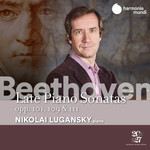|
Back
11/11/2020
“Beethoven: Late Piano Sonatas”
Ludwig van Beethoven: Piano Sonata in A major, n° 28, opus 101 – Piano Sonata in E major, n° 30, opus 109 – Piano Sonata in C minor, n° 32, opus 111
Nikolai Lugansky (piano)
Recording: Moscow Conservatory, Moscow, Russia (July 11-14, 2020) – 69’
harmonia mundi # HMM902441 (Distributed by PIAS) – Booklet in French, English and German

   
Nikolai Lugansky performs three Beethoven “Late Sonatas” in a new album released this month by harmonia mundi as part of their tribute to this composer during his 250th anniversary year. The sonatas in question are not the expected sequence of n° s 30 through 32, but rather n° s 28 (opus 101), 30 (opus 109), and 32 (opus 111). This talented artist has other surprises in store for us, as well, as he treads the treacherous pathway of these difficult and, to some, daunting keyboard conundrums.
Beethoven’s late piano sonatas have been the subject of many books and papers and have pushed our imagination, and sometimes patience, to the limit. Performances can range from the pedantic and powerful to the puzzled and paradisical. Stravinsky’s comment about Beethoven’s Grosse Fuge, that it would be contemporary forever, applies equally to these final works, especially the Sonata n° 32 in C minor, completed in 1822 just five years before the composer’s death. That last movement, with its stratospheric triplets tinkling like shattered crystal, and trills that flutter on for pages, bespeaks a world of thoughts that in Keats’ words “do lie too deep for tears.”
Lugansky approaches these three works consistently while respecting the great variety that makes each sonata unique. Consider Sonata n° 28. Lugansky’s nimble fingers strike the keys vigorously, as though he is playing Prokofiev rather than a late classical master, an approach that is “just right” for many connoisseurs while others (myself included) crave more subtle shades of beauty. We know, of course, that “loud and fast” is how the deaf composer would have played in the final decade of his life, striving to hear his own creations. While lacking warmth, this approach offers sharp edges and a breathless drive which just could be appropriate for our time. The work ends with a powerful statement of assertion and resolution.
The Sonata n° 30 picks up on this momentum in two fast-paced movements followed by another one of Beethoven’s extraordinary sets of late period variations. Lugansky focused on each variation individually, as though a universe unto itself, rather than linking them as one inevitable surge toward the finale. This interpretation was a bit choppy for me, though the pianist’s tendency to hit the keys hard, especially in the higher register, worked well in the edgy second movement. Still, my own personal taste was for an outpouring of liquid tones inspired by the composer’s blazing intelligence and deeply wounded spirit.
How pianists perform the two-movement Sonata n° 32 is, for many, the test of their stature as artists and their depth of mind and spirit. I found the opening movement a bit rattled, filled with nervous energy rather than offering a glimpse of the sublime. But such are the times we live in. While I yearned for a dreamier “Arietta”, the lovely theme at the beginning of the second movement, there was method to the pianist’s approach as he unpacked five variations of spectacular beauty with electrifying force. As the variations swelled, artist and listener rose together beyond the world of critical distinctions, one in which different approaches to the same masterworks can co-exist in harmony.
This is a thought-provoking recording that will have a place in the library of anyone who cherishes Beethoven and the variety of ways in which he speaks to us today.
Linda Holt
|